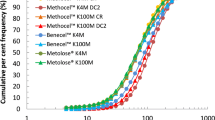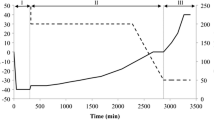Summary and Conclusion
This study investigated the effect of some commonly used release enhancers on the compaction characteristics of EC. The wet granulation method of massing and screening was used, and compacts were produced by compressing granules for 60 seconds at various compression pressures. The Heckel equation, used for the analysis of results, showed that EC alone showed better compressibility than formulations with additives. The hygroscopic additives, sorbitol and PEG 4000, produced unusual Heckel plots, while the nonhygroscopic additives, PEG 10 000 and mannitol, produced biphasic Heckel plots. The results also indicate that EC alone exhibited the highest degree of packing in the die, with the addition of mannitol reducing the extent of packing the most. The presence of additives in EC for-mulations increased the pressures at which plastic deformation of EC granules occurred. The extent of this depended on the type of additive, with mannitol imparting the highest resistance to deformation of EC granules and sorbitol the lowest. It can be concluded that additives such as PEG 4000, PEG 10 000, sorbitol, and mannitol, which are often used as channeling agents in sustained-release formulations containing hydrophobic matrix formers, affect the deformation characteristics of EC, with the extent and nature of the effect dependent on the nature of the additive.
Similar content being viewed by others
References
Polymer Blend Matrix for Oral Sustained Drug Delivery. Pharmaceutical Technology Report 016. 2002. Wilmington, DE: Hercules Incorporated, Aqualon Division. Available at:http://http://www.herc.com/aqualon/pharm/pharm_data_sheets/images/pdf_files/ptr-016.pdf Accessed: May 9, 2006.
Emeje MO.Effect of Molecular Size and Some Hydrophobic Polymers on the Sustained Release Performance of a Gel Forming Polymer [dissertation]. Nsukka, Nigeria: Department of Pharmaceutical Technology and Industrial Pharmacy, University of Nigeria, Nsukka; 2005.
Agrawal AM, Manek RV, Kolling WM, Neau SH. Studies on the interaction of water with ethylcellulose: effect of polymer particle size.AAPS PharmSciTech. 2003;4:E60.
Dürig T, Harcum WW, Lusvardi KM, Skinner GW.Compaction Characteristics of High Ethoxyl, Low Viscosity Ethylcellulose. Pharmaceutical Technology Report 024. 2003. Wilmington, DE: Hercules Incorporated, Aqualon Division. Available at: http://www.herc. com/aqualon/pharm/pharm_data_sheets/images/pdf_files/ptr-024.pdf. Accessed: May 9, 2006.
Joshi HN, Wilson TD. Calorimetric studies of dissolution hydroxy-propylmethylcellulose E5 in water.J Pharm Sci. 1993;82:1033–1038.
Pather SI, Russell I, Syce JA, Neau SH. Sustained release theophylline tablets by direct compression. Part 1: formulation and in vitro testing.Int J Pharm. 1998;164:1–10.
Heckel RW. Density-pressure relationships in powder compaction.Trans Metall Soc AIME. 1961;221:671–675.
Heckel RW. An analysis of powder compaction phenomena.Trans Metall Soc AIME. 1961;221:1001–1008.
Odeku OA, Awe OO, Popoola B, Odeniyi MA, Itiola OA. Compression and mechanical properties of tablet formulations containing corn, sweet potato, and cocoyam starches as binders.Pharm Technol. 2005; April 2:82–90.
Krycer I, Pope DG, Hersey A. An evaluation of the techniques employed to investigate powder compaction behavior.Int J Pharm. 1982; 12:113–134.
Itiola OA, Pipel N. Tableting characteristics of metronidazole formulations.Int J Pharm. 1986;31:99–105.
Emeje MO, Kunle OO. Effect of two surfactants and mode of incorporation on the compaction characteristics of the hot water leaf extract of.Ficus Sur. J Nutraceuticals Functional Med Foods. 2005; 4:147–156.
Al-Omran MF, Al-Suwayeh SA, El-Helw AM, Saleh SI. Taste masking of diclofenac sodium using microencapsulation.J Microencapsul. 2002;19:45–52.
Lachman L, Lieberman HA, Kanig JL.The Theory and Practice of Industrial Pharmacy. Philadelphia, PA: Lea & Febiger; 1986.
Author information
Authors and Affiliations
Corresponding author
Additional information
Published: July 14, 2006
Rights and permissions
About this article
Cite this article
Emeje, M.O., Kunle, O.O. & Ofoefule, S.I. Compaction characteristics of ethylcellulose in the presence of some channeling agents: Technical note. AAPS PharmSciTech 7, 58 (2006). https://doi.org/10.1208/pt070358
Received:
Accepted:
Published:
DOI: https://doi.org/10.1208/pt070358




